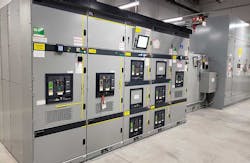Examining the Relationship Between Data Center PUE and Colocation TCO
Tim Mirick, Senior Vice President of Sales and Marketing for Sabey Data Centers, explores Green Grid’s Power Usage Efficiency within the data center industry. Greater facility efficiency and data center PUE are largely tied to lower colocation TCO.
Tim Mirick, Senior Vice President of Sales and Marketing, Sabey Data Centers
Since 2006, Green Grid’s Power Usage Efficiency (PUE) has been the metric for data center efficiency. This ratio is determined by dividing the amount of power entering a facility by the amount used to support the IT load. The closer a facility gets to a 1:1 ratio, the better, though even the best data centers are slightly above 1. The most efficient facility at Sabey’s Quincy, Washington campus, for instance, has an average annual PUE of 1.13, which is considered exceptional.
PUE’s purpose is to show management how much electricity is utilized by non-IT equipment such as air handlers and lighting. So for example, a PUE of 1.13 indicates that, for every 1 kilowatt of IT power used, the facility itself consumes 0.13 kilowatts on cooling, lighting and other non-IT functions.
The correlation between PUE and colocation TCO
PUE is an especially crucial metric in determining the total cost of ownership for leasing a colocation data center. In addition to rent, a colocation tenant pays for the electricity needed to support their IT infrastructure along with the overhead associated with the PUE. Greater facility efficiency consequently equates to lower total cost of ownership (TCO).
Take the example of cooling and air handling. Keeping servers cool is a notoriously expensive endeavor, one that contributes to a higher PUE. Companies such as Facebook have attempted to move data centers to the Arctic Circle to circumvent the cost of cooling. Microsoft, meanwhile, is experimenting with submarine data centers.
For a colocation data center provider, moving to the ocean or the Arctic Circle might be impractical. Still, they need to work hard to keep costs down for their customers, which they can do through methods such as hot-aisle containment, a form of passive airflow that relies on heat rising into ceiling return plenums so it can be cycled back into air conditioners with minimal additional energy usage from fans.
When considering a new colocation facility, one can manage PUE risk by selecting a data center that is being built with the same design and in the same climate as an existing facility that has a strong average PUE.
In addition to containment, other factors that can contribute to a colocation facility’s PUE include the type of equipment being used by the provider, cooling method, control systems used by the operations team, lighting systems, and the equipment and installation methods (e.g. blanking plates) by the customer.
Key considerations for evaluating PUE assurances
While evaluating options, it’s important for customers to first understand the different ways that PUE could be represented:
- Target PUE: This is goal PUE of the colocation facility, and it doesn’t necessarily reflect operational reality.
- Theoretical PUE: An achievable PUE under certain ideal circumstances, it can also be a snapshot during a low PUE point, but again, it isn’t reflective of what’s really happening on average in the data center.
- Design PUE: This is the projected PUE of a facility that is currently under construction.
- Average PUE: The metric with potential to be the most reliable, average monthly or annual PUE is exactly what it sounds like. It provides the average, actual PUE for an allotted period of time. Critically, though, it’s important to consider how often the provider is measuring in order to calculate these averages. It’s fairly easy to “fudge the numbers” by selectively sampling PUE during its known low points.
- Peak PUE: Also useful, peak PUE identifies the facility’s PUE under the most strained condition – for instance, on an unusually hot day in July.
It’s also worth investigating the factors a provider does or does not include in PUE and how they’re measuring to ensure that they aren’t manipulating their numbers. For example, are they factoring in energy lost in cabling? How closely to the IT equipment are they measuring a server’s power consumption? Measuring farther from a server will yield a higher consumption reading.
Be mindful of these and other factors as you assess your options.
Efficiency mostly boils down to credibility
An existing facility with a proven PUE track record will most likely come closest to meeting expectations. There’s some risk involved when evaluating new facilities with either a new design or in a new climate, since you’ll primarily assess efficiency on a design PUE, a theoretical PUE or an average pulled from a relatively small sample size.
When considering a new colocation facility, one can manage PUE risk by selecting a data center that is being built with the same design and in the same climate as an existing facility that has a strong average PUE.
At the end of the day, the best and most effective way to assure a low TCO is by carefully assessing a provider’s PUE track record across all facilities and locations.
Tim Mirick is the Senior Vice President of Sales and Marketing for Sabey Data Centers.
For information about Sabey’s PUE track record, check out this video case study, or contact us directly.


